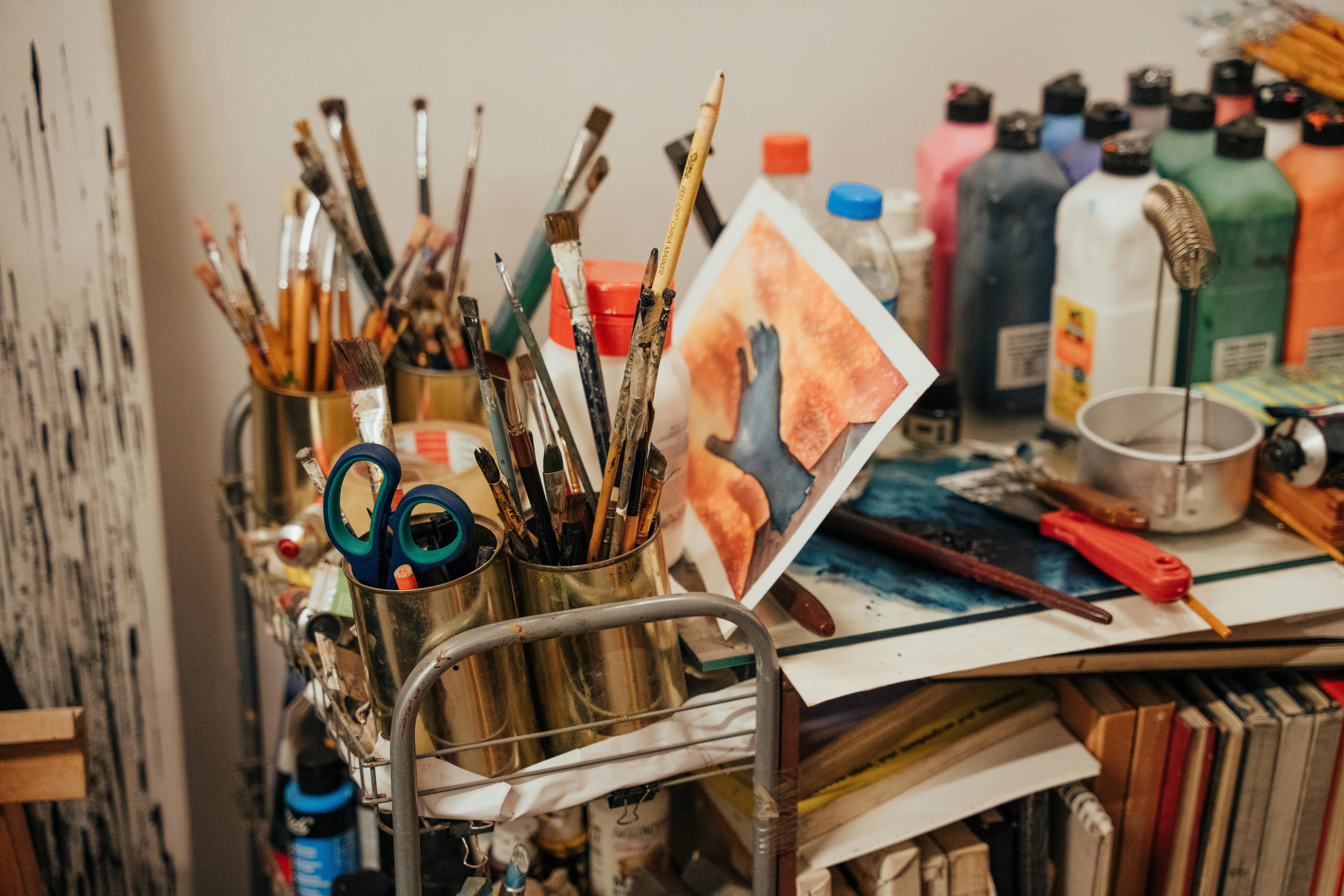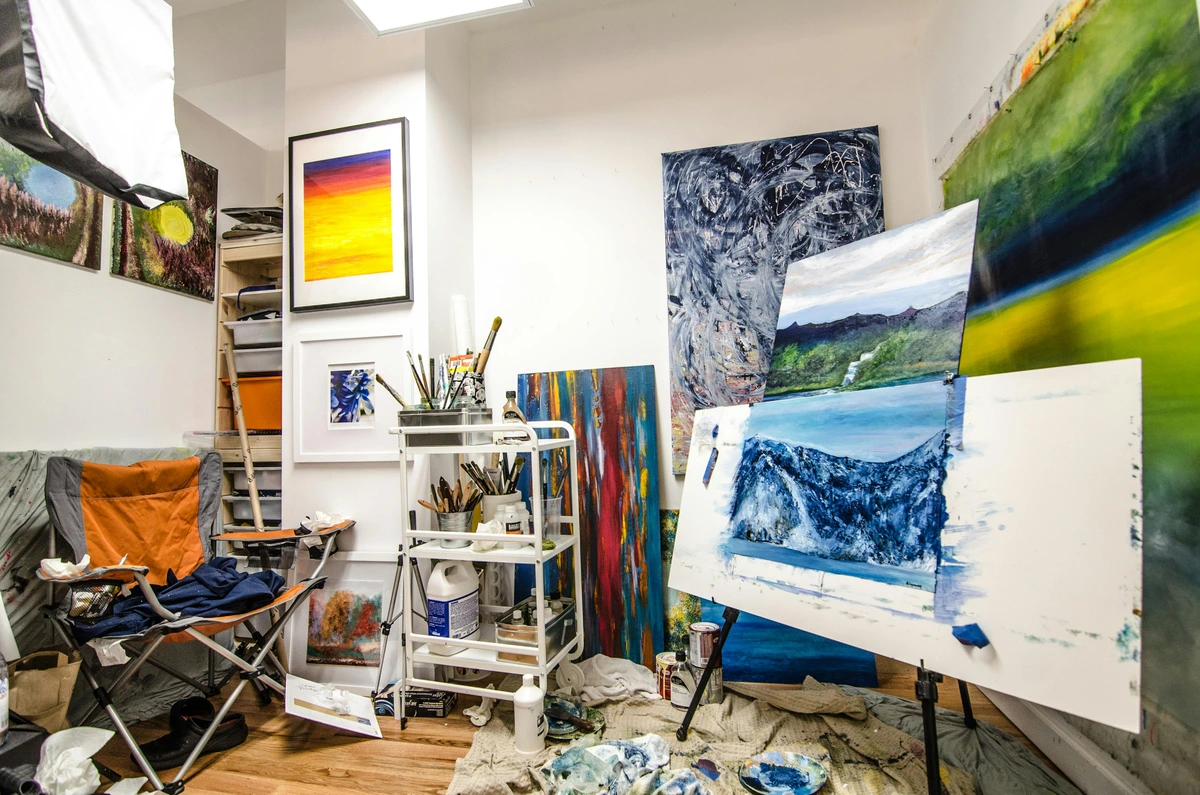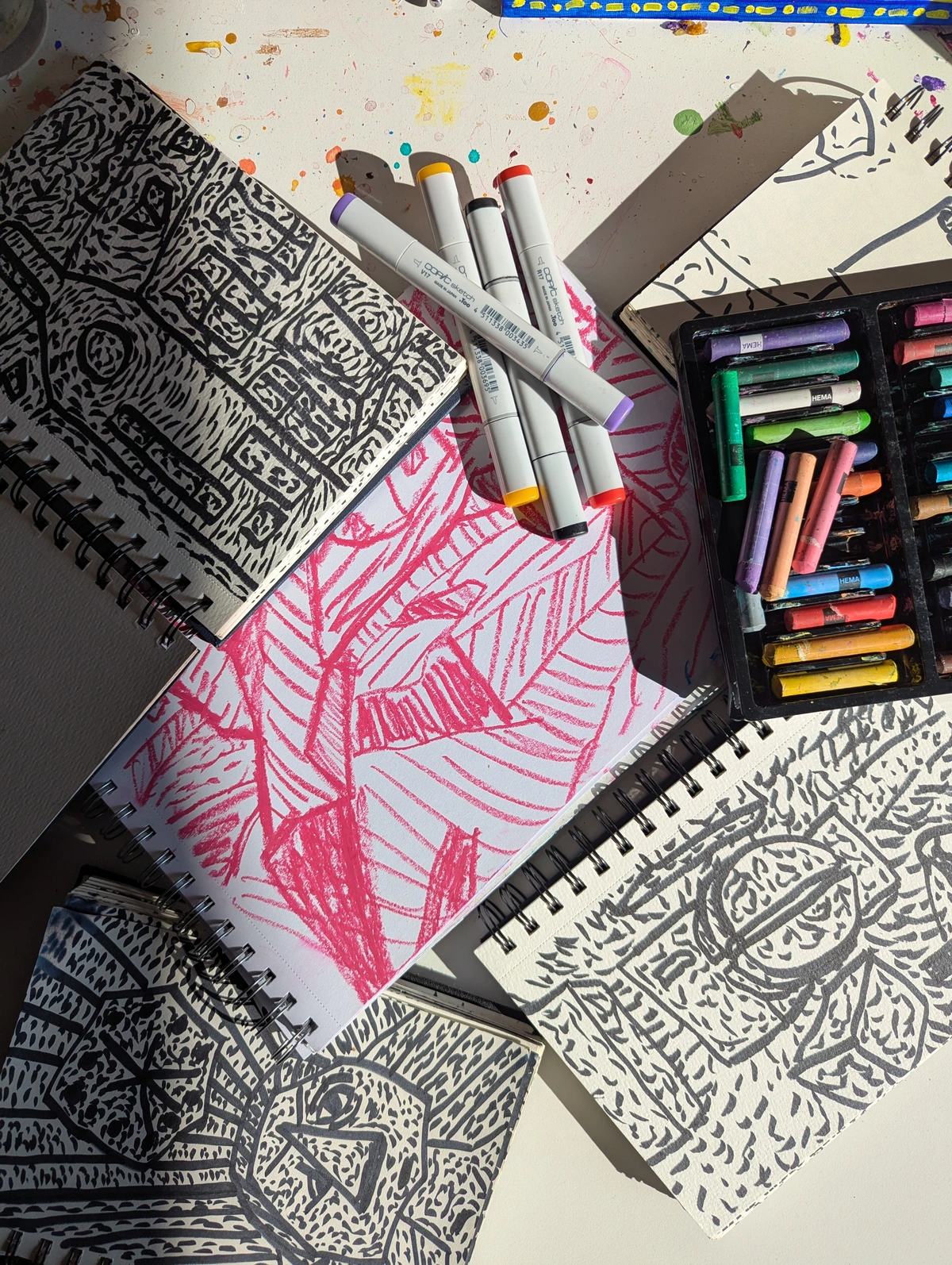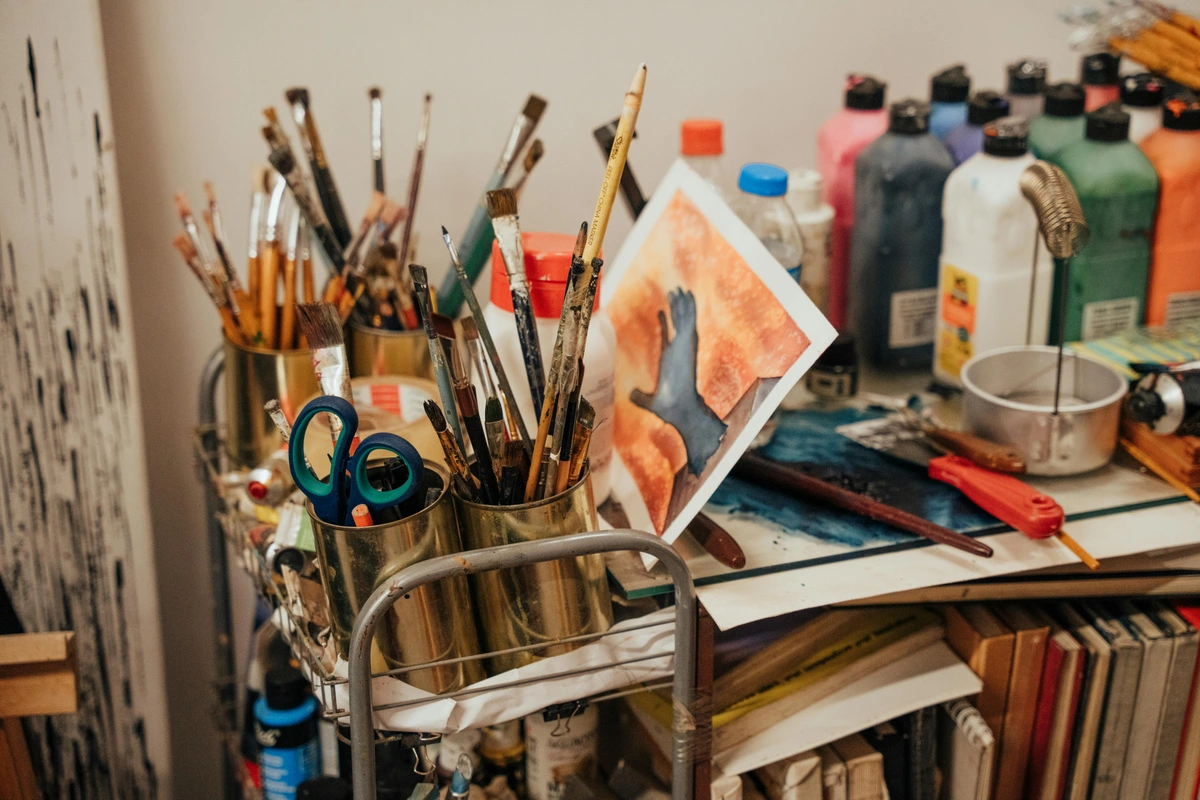
Everyday Abstraction: Fueling Art & Vision from Mundane Moments
Discover how mundane moments—from dust motes to coffee stains—profoundly fuel my abstract art. Explore my unique philosophy, specific inspirations, and practical methods for transforming everyday observations into vibrant, textured works.
Finding Abstraction in the Everyday: How Mundane Moments Fuel My Creative Vision and Art Practice
My brain, it seems, operates on a slightly different frequency than most. While some might find my deep fascination with dust motes or drying water stains a tad peculiar, or even unproductive—like that time my partner caught me mid-stare, completely mesmerized by the evolving fractal edges of a drying water stain on the kitchen floor, asking if I was finally losing it—this seemingly random focus on the overlooked is, in fact, the very core of my artistic practice. It's how I find profound abstraction in the everyday, translating the quiet hum of mundane moments into vibrant, textured works of art. This isn't just a quirky habit; it's a deep-seated philosophy that informs why I paint abstract, where the canvas becomes a space not for strict representation, but for the distillation of fleeting moments, emotional undertones, and the hidden structures of daily life. In this article, I'll share how I translate these overlooked moments into my abstract art, exploring my philosophy, practical examples, and how you can cultivate your own perceptive eye.
If you've ever wondered where artists truly get their ideas, especially for abstract art that doesn't depict anything recognizable, well, for me, it’s often found in the most unassuming places. It's not always grand vistas or profound experiences; sometimes, it's just the fleeting glimpse of peeling paint on an old wall, or the intricate tangle of wires behind my computer. And honestly, it’s a lot less expensive than traveling the world for inspiration, which, let’s be honest, my budget (and my cat's demands) doesn't always allow. This perpetual hunt for the unnoticed is, in essence, where the artist's muse truly resides for me, a muse quite content with the chaos of my desk.
The Unseen Palette: My Philosophy of Mundane Inspiration
My philosophy for abstract art is quite simple: everything is a potential painting waiting to happen. It's about extracting the raw essence of reality, its hidden structure, and its emotional resonance. Think of it like when I'm cooking: tasting a complex dish and meticulously isolating individual flavors—I do that with visual and emotional sensations. For instance, the sharp, bright zing of a lemon might translate into a painting dominated by crisp, energetic yellow lines and angular forms, embodying that distinct sensory experience. But don't misunderstand, it's not about trying to perfectly recreate a 'recipe' on canvas; it's about capturing the feeling of those flavors. The crinkle of a plastic bag isn't just noise; it’s a study in form and tension. The chaotic order of clothes drying on a line? A masterclass in line and repetition. The unexpected shadow cast by a wilting plant? A poignant composition of light and impermanence. These aren't just objects; they are compositions, color studies, and emotional landscapes waiting to be translated. This approach to art is distinct from purely formalist abstraction, which might focus solely on color and shape for their own sake, or purely spiritual abstraction, which seeks to express the divine. Instead, my work is deeply grounded in the tangible; it takes that seemingly insignificant detail—the chaotic order of laundry, the unexpected shadow—and elevates it, giving it a voice on the canvas not as a literal depiction, but as a felt experience rooted in the tangible, often overlooked, reality of everyday life.
This isn't merely a way of seeing; it’s a way of being. It's a continuous process of observing and translating that transforms the ordinary into the extraordinary, proving that my connection to abstract art is deeply rooted in this personal interpretation of the world. It’s a quiet assertion that profound beauty and meaning are woven into the fabric of daily existence, if only we pause long enough to notice. In many ways, it's a practice of mindfulness, similar to the principles behind abstract art as a daily practice. This philosophy isn't just an abstract concept; it manifests in tangible ways throughout my daily life, guiding how I perceive and create, as I'll explore next.

For me, this philosophy is also a personal anchor. In a world often overwhelming with grand narratives and constant demands, finding deep meaning in the small, unassuming corners of existence offers a quiet sanctuary. It's an act of defiance against the pressure to always be producing, achieving, or seeking external validation. Instead, it invites me inward, to a place where my own perceptions are the most valuable tools, and where the act of seeing itself becomes a profound creative act. It’s a way of affirming that my unique way of experiencing the world holds inherent artistic value.
From Morning Coffee to Midnight Musings: Everyday Moments as Creative Sparks
Let me walk you through some of the everyday scenarios where my "abstract goggles" really kick in. You might be surprised how much artistic potential is hiding in plain sight.
The Rhythm of Routine
There's a curious, almost hypnotic beauty in repetition. That daily walk to the studio, the way the light changes minute by minute on the same stretch of pavement, or the swirling patterns in my morning tea as I stir it. These aren't just monotonous tasks; they're opportunities to observe subtle shifts, to feel the rhythm of existence. The steady beat of life, often ignored, becomes a pulse I can capture through repeated marks or layered textures in my work. For example, a series like "Urban Cadence" might feature recurring lines and muted tones mirroring daily commutes, capturing the visual cadence of the city, while "Morning Brew" could use subtle, layered striations to evoke the concentric circles and steam rising from a cup. It's about finding the underlying structure in life's apparent chaos – like the hidden grid in a brick wall or the predictable undulation of a passing train – a kind of quiet meditation on continuity. It’s a contemplation of how small, consistent movements and patterns weave into the larger tapestry of existence, a gentle reminder that even in urban bustle, there's a predictable pulse.
Accidental Beauty
Oh, how I adore accidental beauty! The way paint has dried on my studio floor, forming an unintended masterpiece of cracks and color. The forgotten grocery list with scribbled notes and a coffee stain that somehow feels perfectly balanced, a study in brown and faded blue, might morph into a piece like "Coffee Stain Symphony," celebrating the beauty in imperfection. Or consider the rich, uneven patina of rust on an old metal gate, forming an intricate, textured landscape of ochres and reds. These fleeting, often imperfect compositions are pure, unadulterated abstraction because they exist without human intent to represent anything specific. They teach me about spontaneity, the joy of letting things simply be, and the unexpected gift of serendipity, which is also a big part of the art of intuitive painting.
Emotional Echoes
Beyond the purely visual, there's the emotional landscape of the everyday. A phone call with a friend, a moment of quiet reflection during a train ride, the rush of traffic outside my window. These interactions and sensations leave an emotional residue. Sometimes it's a vibrant burst of joy, translating into an energetic splash of yellow or orange and perhaps bold, sweeping brushstrokes. Other times, it's a somber, muted gray from a moment of melancholy or introspection, expressed through subtle washes and diffused textures. For instance, the quiet, simmering frustration of endless forms and slow progress could be translated into a composition of tightly packed, almost vibrating, monochromatic lines on a stark, off-white background—each line a testament to repetitive nature, with a faint, underlying red hinting at tension. These feelings, though intangible, translate directly into my choice of palette, the intensity of my strokes, and the overall mood of a piece. "Morning Rush," for instance, might explode with energetic, overlapping strokes of vibrant yellow and orange, capturing the city's awakening with sharp, angular forms. In contrast, "Commute Reflections" could use deep, blended blues and purples with soft, blurred edges to evoke the quiet introspection of a journey. Understanding the emotional language of color is key here, as every shade and hue can carry a whisper of daily experience, like a secret code embedded in the canvas. It's as if the canvas becomes a silent interpreter of the heart's quiet hum throughout the day.

Beyond the Obvious: Finding Abstraction in Uninspiring Moments
"But what if my daily life feels boring, and inspiration feels elusive?" This is a question I often encounter, and it's a valid one. Not every moment is a sun-drenched epiphany. Sometimes, the mundane is just... mundane. Or even worse, frustrating. Yet, even in these less-than-picturesque scenarios, the potential for abstraction lingers, waiting for a shift in perspective. Initially, I'd probably scoff at the idea of finding art in a mountain of paperwork, but necessity, as they say, is the mother of invention—and sometimes, of surprisingly compelling abstract compositions. The trick is to find the extraordinary in the boring, or even the challenging.
Think about the quiet frustration of a bureaucratic task – the repetitive forms, the slow progress, the mind-numbing checkboxes. Instead of focusing on the irritation, I might observe the rhythm of the pen, the texture of the official paper, or the unintentional patterns formed by repeated signatures. That quiet, simmering frustration could be translated into a composition of tightly packed, almost vibrating, monochromatic lines on a stark, off-white background—each line a testament to the repetitive nature, and the subtle tension hinted at by a faint, underlying red, perhaps achieved with thin glazes or a controlled use of a dry brush. Or the monotonous drone of background noise might manifest as a series of consistent, layered textural elements, like a visual hum created with impasto medium or heavy gel. It's about detaching from the meaning of the moment and isolating its pure, abstract components: its colors (or lack thereof), its textures, its implied shapes, its inherent rhythms, or the subtle emotional echo it leaves. This kind of observation transforms even the most uninspiring moments into valuable studies in form, emotion, and perception, contributing to a truly unique artistic style.

My "Abstract Goggles": Cultivating a Perceptive Eye
So, how do I train myself to see this way? It’s less about a magic trick and more about conscious cultivation through specific practices:
The Art of Slow Observation
In our fast-paced world, slowing down feels almost rebellious – a defiant quiet in a world demanding constant noise – but it's utterly essential. I try to carve out moments each day—even just five minutes—to simply observe without judgment or agenda. Watching steam rise from a cup, noticing the intricate pattern of a leaf, or just listening to the distant, layered sounds of the city. This practice isn't solely for art; it's a gateway to mindfulness and a deeper, more present connection with the world. I remember one particularly dreary morning, feeling utterly uninspired, I simply watched a single leaf slowly detach from a branch outside my window. The subtle shift of colors as it fell, the way it twisted in the air, the gentle landing on a puddle, creating ripples – it wasn't about drawing the leaf, but about the fleeting dance of gravity, color, and light, a poignant study in impermanence that later found its way into a series exploring 'Ephemeral Descent' using soft, swirling brushstrokes and muted greens and browns. It’s where the seeds of my unique artistic style are truly sown. Try this: pick one object near you right now, perhaps the pattern on your keyboard or the way light hits your water glass. For 60 seconds, just look at it. What colors are truly there? What lines? What textures? What light? Forget what it is, and just see its visual components. It's a powerful path to mindful moments.
Journaling the Ephemeral
My sketchbooks aren't filled with realistic drawings; they're packed with scribbles, color notes, and abstract forms. A quick note about "the chaotic energy of the bus stop," or "the soft, diffused light of a rainy afternoon." Sometimes it's something as cryptic as "That feeling of Monday morning, but in blue-grey, with a jagged line." These are visual and textual reminders of those fleeting inspirations, often accompanied by quick, gestural marks or color swatches. They serve as a vital bridge between the observation and the eventual painting, a kind of shorthand for a momentary perception.

Deconstructing Reality
When I look at an object, I try to see beyond its literal form, beyond its conventional name. What are its dominant colors? What textures can I discern—is it smooth, rough, pitted, or flaky? What shapes are implied, even if they're not geometric? It's about breaking down complex realities into their fundamental abstract components. For example, a crumpled receipt on the floor isn't just trash; it's a landscape of sharp creases, soft shadows, the subtle yellowing of paper, and the rhythmic pattern of printed text. This process is akin to a geologist studying rock formations, not to replicate the mountain, but to understand its underlying structure and the forces that shaped it. While movements like Cubism broke objects into geometric forms, or Analytical Abstraction dissected subjects to their fundamental elements, my process is more intuitive and grounded in lived experience. It shares that core desire to see through the obvious, revealing the abstract truths beneath, but it's less about a formal analytical system and more about a direct, felt translation of the tangible. This approach significantly informs my exploration of texture in abstract art and how I build depth in my paintings through layering and mark-making.
Translating the Mundane to the Canvas: My Process
Once I've gathered these observations—these whispers of everyday abstraction—the next step is the studio. This is where those cultivated observational skills find their practical application. This isn't a precise, scientific conversion; it's an intuitive dance, a conversation between memory and material. It's like feeling the quiet hum of a distant city through your feet, then translating that subtle vibration into something visual on the canvas. The emotion from that conversation, the rhythm of that walk, the accidental beauty of that spilled paint—they don't get literally depicted. Instead, they inform the initial marks, the chosen palette, and crucially, the tactile qualities of the paint itself. I might choose high-viscosity acrylics to create thick, sculptural impasto reminiscent of peeling paint, or thin, watery washes that mimic diffused light. The pigment load and drying time also become tools, allowing me to build translucent layers for a sense of depth and mystery, or opaque, bold statements. I might also incorporate specific mediums like modeling paste for extreme texture, or fluid acrylics for smooth, flowing effects, all inspired by the material properties observed in daily life.
Of course, not every observation becomes a masterpiece. There are countless scribbles, failed studies, and moments where the translation simply doesn't connect. These "dead ends" are just as valuable, teaching me about what doesn't resonate, refining my eye, and pushing me to explore new ways of seeing and expressing. My step-by-step abstract painting process often begins with a memory or a feeling from one of these mundane moments. It's less about a clear plan and more about letting that initial spark guide the brush, allowing the piece to evolve organically. It's a deeply personal conversation between the external world I've observed and the internal world of my imagination, a dance of intuition that also characterizes my creative flow.

The Enduring Impact of Everyday Abstraction
This practice of finding abstraction in the mundane has profoundly shaped not just my art, but my entire way of experiencing the world. It’s transformed my daily life from a series of tasks to a continuous wellspring of creative possibility. It teaches patience, encourages deep presence, and reminds me that beauty is not exclusive to grand landscapes or dramatic events, but is woven into the very fabric of our everyday existence.
For me, the canvas becomes a mirror, reflecting these quiet observations back, allowing viewers to find their own hidden worlds within the abstract forms. It's about creating art that resonates not because it depicts something specific, but because it captures a universal feeling, a subtle rhythm, or an accidental beauty that we all encounter, yet often overlook. This is truly what makes abstract art compelling, as it invites a deeper, more personal form of engagement. My recent series, "Urban Rhythms," for instance, directly translates the visual cadence of city life, much like how the consistent patterns of a brick wall or the undulation of a train might inspire a piece from my "Daily Textures" collection, available in my collection of art for sale.
FAQ: Abstract Inspiration from Daily Life
Q1: Do I need to be an artist to find this inspiration?
Absolutely not! Anyone can cultivate this way of seeing. It's about enhancing your perception and being more present. You don't need a brush; just an open mind and a willingness to notice. This mindful way of seeing can also be a quiet form of self-care, a moment to reset amidst the noise. It’s a powerful path to mindful moments.
Q2: How do I start seeing abstractly?
Start small. Pick one mundane object near you right now. What colors do you see? What shapes are implied? What textures? Try to forget what it "is" and just see its visual components. Here are a few ideas:
- A crumpled piece of paper: Notice the sharp creases, soft shadows, the subtle yellowing, and the rhythmic pattern of printed text.
- The bark of a tree: Observe its unique texture, the way moss might grow in patterns, or the light filtering through its crevices.
- Your own hand: See the lines, the skin's texture, the interplay of light and shadow, the subtle shift of colors within.
Try to imagine it as a standalone composition, a mini-painting in itself.
Q3: What if my daily life feels boring, and inspiration feels elusive?
Ah, the trick is to find the extraordinary in the boring. The peeling paint on a forgotten bench, the repeating pattern of bricks on a building, the way light filters through a dusty window—these are the hidden gems. Even stillness can be a powerful abstract concept. Embrace the quiet; it often reveals the most. If inspiration feels elusive, sometimes simply changing your perspective—literally, kneeling down to see something from a new angle, or looking up at the sky while lying on the grass—can unlock new observations. And remember, not every observation needs to become a painting; sometimes the act of noticing is enough.
Q4: Does this apply to all abstract art?
While many abstract artists draw from diverse sources, observing the everyday is a common thread. However, my approach, which directly translates tangible, observed phenomena and emotional echoes into abstract form, differs from, say, a purely geometric abstraction focused on mathematical precision, or lyrical abstraction driven by spontaneous, musical impulses. My work is grounded in the felt reality of daily life, making it a distinct facet of what makes abstract art compelling.
Q5: How do you handle days when inspiration feels completely absent or the mundane is just... mundane?
Ah, the artist's perennial struggle! It happens to everyone. On those days, I often lean into the 'boring.' Instead of forcing a grand vision, I might focus on purely technical studies: mixing a hundred shades of grey, experimenting with different brushstrokes, or just cleaning my studio. Sometimes, a physical change of scenery helps, even if it's just stepping outside for five minutes. And crucially, I remind myself that creativity isn't a faucet; it's a well that needs to be refilled. These quiet moments, even the uninspired ones, are part of that refilling process. They allow for internal processing, and often, a new way of seeing emerges when I'm not actively looking. Moreover, I make it a point to document even the most unassuming observations in my journal. A quick scribble, a color note, or a cryptic phrase about a momentary feeling can become a valuable seed for a future artwork, even if its potential isn't immediately apparent.
My Invitation to You: See the World Differently
So, the next time you're waiting for your coffee to brew, or stuck in traffic, or just doing the dishes, pause. Put on your own "abstract goggles." Look around. What unnoticed patterns, colors, or textures can you find? What emotions are stirring within you as you go about your day?
For me, these mundane moments are not just gaps between the exciting bits of life; they are the exciting bits, waiting to be seen through an artistic lens. They are the quiet, rich soil from which my abstract vision grows, culminating in the unique, often highly textured and colorful pieces you can find in my collection of art for sale. Many of the works displayed, especially those featuring subtle textures or repetitive marks, directly reflect observations of daily rhythms and accidental beauty. Perhaps, if you're ever in the Netherlands, you might even spot some of these everyday inspirations reflected in the works at my museum in 's-Hertogenbosch. It's a journey, a timeline of observation and creation that continues to unfold, where you can trace the evolution of my artistic journey and the inspirations that have shaped my work over the years, inviting you to see your own world with new eyes, and perhaps, find your own reflection in the abstraction of everyday existence. What mundane moment will you choose to explore today? Share your discoveries and let's unravel the hidden beauty together!




